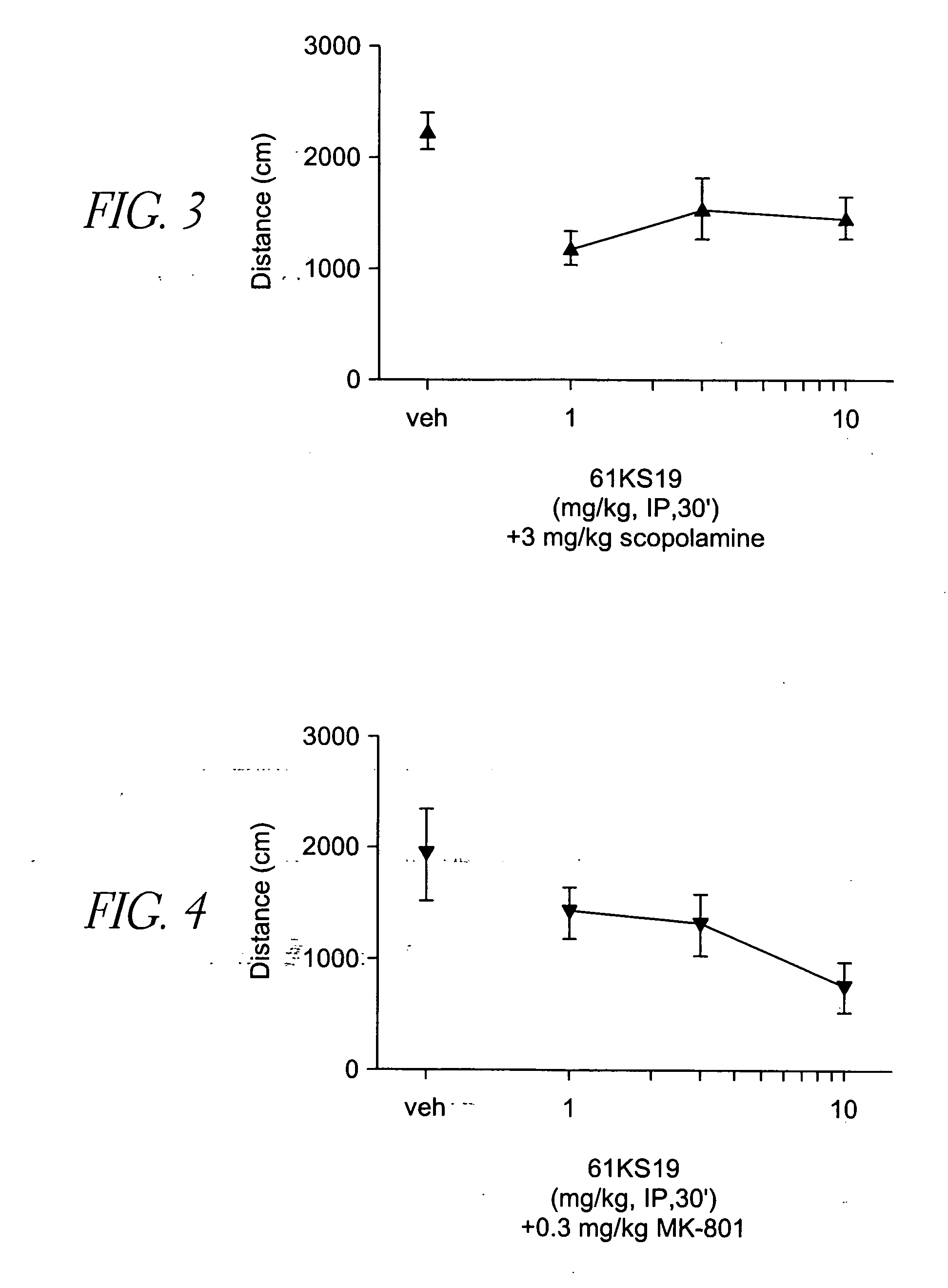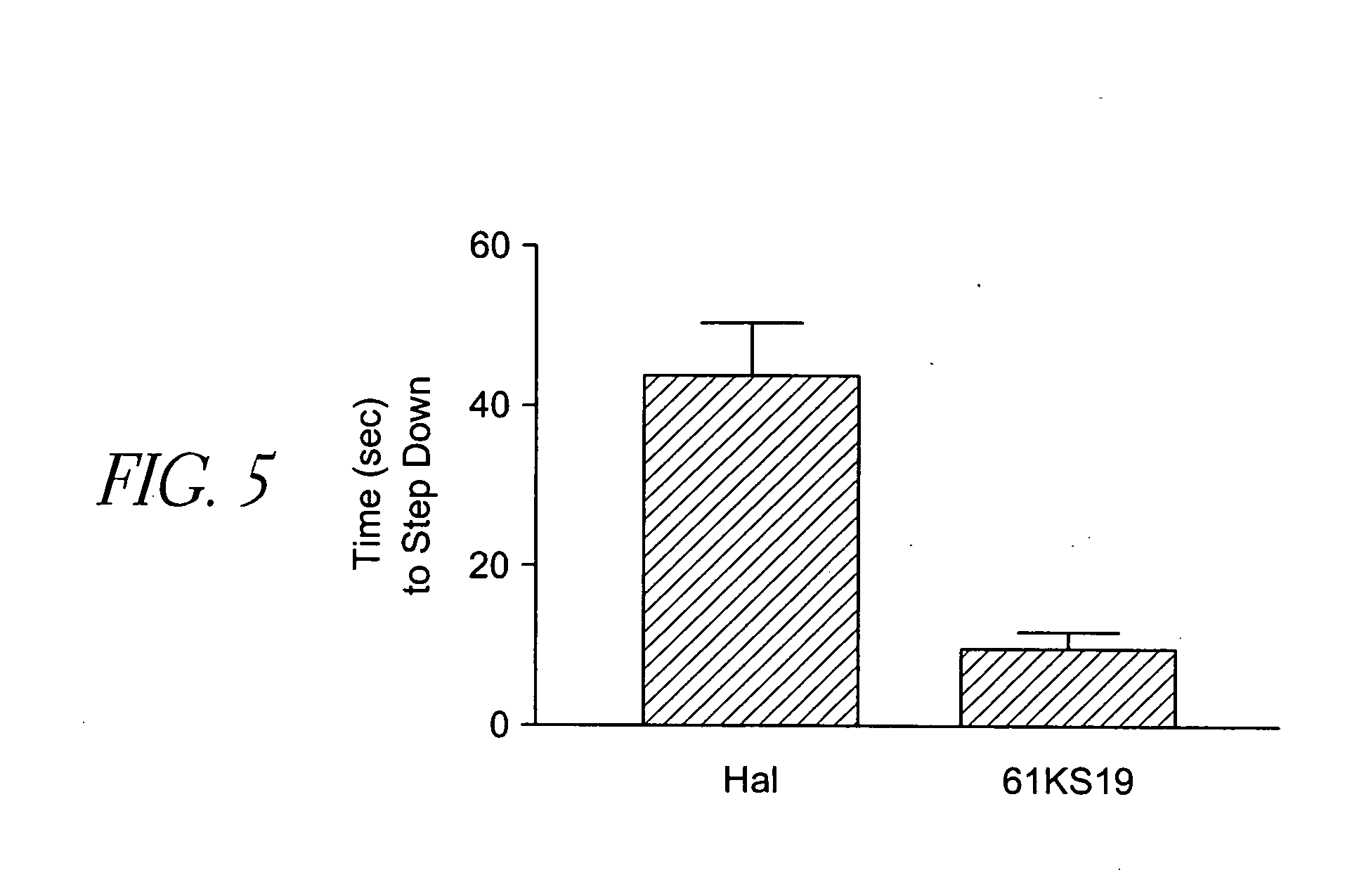Benzimidazolidinone derivatives as muscarinic agents
a technology of benzimidazolidinone and derivatives, which is applied in the direction of biocide, solid-state diffusion coating, drug compositions, etc., can solve the problems of frequent cholinergic side effects, significant hepatotoxicity, and inability to augment central cholinergic function through the administration of choline or phosphatidylcholine, etc., to achieve the effect of increasing acetylcholine signaling or
- Summary
- Abstract
- Description
- Claims
- Application Information
AI Technical Summary
Benefits of technology
Problems solved by technology
Method used
Image
Examples
example 1
[0140] In the present example, methods for R-SAT and radioligand binding are described. In addition, screening of test compounds in assays using muscarinic receptor subtypes M1 and M4 and dopamine receptor subtype D2 are described.
Methods
[0141] The M1 and M4 muscarinic receptor subtypes were cloned substantially as described by Bonner et al., (1987) Science 273 p. 527 and Bonner et al, (1988) Neuron 1, p. 403. R-SAT assays were carried out substantially as described in U.S. Pat. No. 5,707,798 and by Braüner-Osborne, H. B. and Brann, M. R. (1995), Eur. J. Pharmacol. 295:93-102. NIH-3T3 cells (available from the American Type Culture Collection as ATCC CRL 1658) were transfected with plasmid DNA encoding the m1 and m4 receptors and plasmid DNA encoding β-galactosidase. Transfected cells were grown in the presence of between 1 nM and 40 μM of the test compound for 5 days. On day 5, the cells were lysed using 0.5% nonidet-P and β-galactosidase expression was quantifie...
example 2
Behavioral Studies
Methods
Animals
[0147] Male Non-Swiss Albino mice (Harlan Sprague-Dawley) were housed (4 mice / cage) in rooms with temperature and humidity controlled and water and food (Harlan Teklad) freely available. Mice were kept on a 12-hr light:dark cycle.
Procedure
Locomotor Activity
[0148] Plastic 20×20×30 cm activity cages were equipped with photocell beams (AccuScan Instruments). For spontaneous activity, 61KS19 (1, 3 and 10 mg / kg) was administered alone i.p. 30 min before the session. For hyperactivity experiments, mice were treated with 0.3 mg / kg dizocilpine, 3.0 mg / kg d-amphetamine or 3.0 mg / kg scopolamine i.p. 15 min before the session (15 min after 61KS19). Locomotor data were collected during a 15 min session without habituation in a lit room. Each dose combination was tested in a separate group of animals (n=8). Distance traveled (cm) was calculated and averaged followed by ANOVA and post-hoc Dunnett's t-test comparisons.
Catalepsy
[0149] A custom-built 8-mm...
example 3
Synthetic Procedures
3.1 General Preparative LC-MS Procedure
[0150] Preparative purification was performed on a Waters auto purification system (600 pumps, 2700 sample manager, 996 PDA detector, ZMD massspectrometer).
[0151] The columns used were YMC C18 J'sphere ODS H80. Buffer A was 0.15% TFA in water, buffer B was 0.15% TFA in acetonitrile / water 95 / 5. The columns were operated at 17 ml / min. Following an initial hold of 2.5 min at 30% buffer B, compounds were separated using a gradient af 30-100% buffer B in 8.5 min. A dual column setup with two pumps was used to equilibrate one column, while running on the other.
3.2 3-Trifluorosulfonyl-8-tertButyloxycarbonyl-8-azabicyclo[3.2.1]-oct-2-ene (N-Boc-nortropanone enol triflate) (104KS22)
[0152] LDA was generated by adding BuLi (20 mL, 1.68M, 32.6 mmol) to a solution of diisopropylamine (2.38 g, 32.6 mmol) in dry THF (10 mL) at −78° C. under argon. The mixture was kept at that temperature for 30 min followed by the addition of a soluti...
PUM
 Login to View More
Login to View More Abstract
Description
Claims
Application Information
 Login to View More
Login to View More - R&D
- Intellectual Property
- Life Sciences
- Materials
- Tech Scout
- Unparalleled Data Quality
- Higher Quality Content
- 60% Fewer Hallucinations
Browse by: Latest US Patents, China's latest patents, Technical Efficacy Thesaurus, Application Domain, Technology Topic, Popular Technical Reports.
© 2025 PatSnap. All rights reserved.Legal|Privacy policy|Modern Slavery Act Transparency Statement|Sitemap|About US| Contact US: help@patsnap.com



